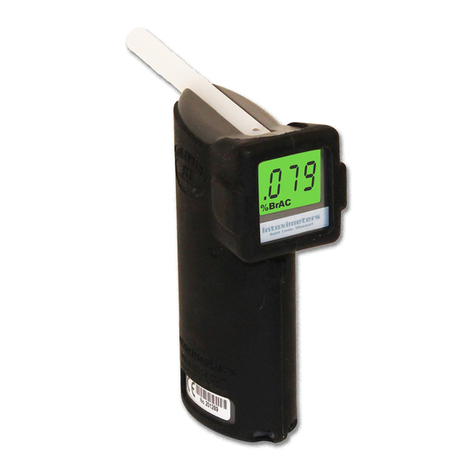
-9-
ALCO-SENSOR FST® CALIBRATOR’S MANUAL
6.4 Alco-Sensor FST® CALIBRATION PROCEDURE
NOTE: Record alcohol standard information and test results on corresponding log sheet.
PREPARATION OF SIMULATOR
Ensure jar and tubing are clean and dry. Pour in “100" solution. Test simulator for leaks. Ensure
propeller is turning. Warm simulator for 20 minutes. Ensure temperature indicates 33.80C to 34.20C.
NOTE: Simulator solution can be used to calibrate more than one unit. It must be discarded after 16
tests or at the end of calibration session.
Record alcohol standard information on the Alco-Sensor FST® calibration log.
ACCURACY CHECK:
1. Attach a new clean mouthpiece and power the
device ON by first pressing and holding the OFF
button and then simultaneously pressing ON button.
2. Press the ON button until ACC appears on the
display.
3. Press the OFF button to select the Accuracy Check
option. The temperature will be displayed followed
by a blank check.
4. While the display shows a flashing ACC, connect
the device to the simulator and introduce simulator
vapour.
5. Detach the device from simulator and wait until the
analysis is complete.
6. Observe the result given on the display and record
result on log sheet.
a) If the result is 95 to 105 mg%, return to Step 1.
b) If the result is less than 95 mg% or greater than
105 mg%, go to Step 1 of the Calibration
procedure.
NOTE:Repeat procedure until two consecutive
responses are in the range of 95 to 105 mg%.
CALIBRATION:
1. Attach a new clean mouthpiece and power the
device ON by first pressing and holding the OFF
button and then simultaneously pressing the ON
button.
2. Press the ON button until CAL appears on the
display.
3. Press the OFF button to select the Calibration
option. This will initiate the calibration sequence
(pass code protected). The temperature will be
displayed followed by a blank check.
4. While the display shows a flashing CAL, connect
the device to the simulator and introduce simulator
vapour.
5. Detach the device from simulator and wait until the
analysis is complete.
6. Observe the result given on the display and record
“CAL” on log sheet.
a) If the result displayed is “100", depress the OFF
button three times to accept the calibration value.
The calibration value will flash three times before
the device will power down.
b) If the result displayed is not “100", use the ON
button to adjust each digit so that “100"is displayed
and confirm each digit by pressing the OFF button.
The calibration value will flash three times before
the device will power down.
7. Return to Step 1 of the Accuracy Check
procedure.
Record results on Alco-Sensor FST® calibration log.































